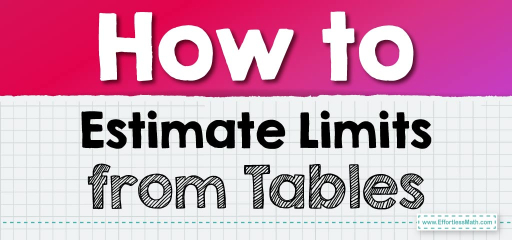How to Estimate Limits from Tables
When given a table of values, you can use it to estimate the limit of a function as \( x \) approaches a particular value. Here's a step-by-step guide on how to do this:

Step-by-step Guide to Estimate Limits from Tables:
1. Understand the Question:
- Ensure you know what you’re being asked. Typically, the question might be something like, “Estimate the limit of \( f(x) \) as \( x \) approaches \( c \)”.
2. Examine the Table:
- Look at the table’s structure. You’ll typically have two columns: one for \( x \) values and one for \( f(x) \) values.
3. Look for the Target x-value:
- Find the x-value you’re approaching in the table (let’s call it \( c )\). The table might not have this exact value, but it should have values close to it.
4. Observe Values from Both Sides:
- Check the function values as \( x \) approaches \( c \) from the left (values slightly less than \( c )\).
- Check the function values as \( x \) approaches \( c \) from the right (values slightly greater than \( c )\).
5. Recognize Patterns and Trends:
- As the \( x \) values get closer and closer to \( c \), what is happening to the \( f(x) \) values?
- Are the \( f(x) \) values approaching a particular number from both sides? Or are they diverging or behaving differently from the left and the right?
6. Make the Estimation:
- If the \( f(x) \) values are getting closer and closer to a specific number as \( x \) approaches \( c \) from both the left and the right, then you can estimate the limit to be that number.
- If the values approach different numbers from the left and right or if they don’t appear to approach any particular number at all, then the limit at \( x = c \) might not exist.
7. Address Special Cases:
- In some tables, the \( x \) value might skip right over \( c \). That’s okay; the limit doesn’t need the function to be defined at \( x = c \). Focus on how the function behaves as it gets close to \( c \), not necessarily at \( c \).
8. Write Your Conclusion:
- State your estimate clearly. For example, “The limit of \( f(x) \) as \( x \) approaches \( c \) is estimated to be \(L\).” Or, “The limit of \( f(x) \) as \( x \) approaches \( c \) does not appear to exist.”
Example:
Suppose you’re given the following table for the function \( f(x) \):
| \( x \) | \(f(x)\) |
|---|---|
| \(1.9\) | \(3.81\) |
| \(1.99\) | \(3.9801\) |
| \(1.999\) | \(3.998001\) |
| \(2\) | \(?\) |
| \(2.001\) | \(4.002001\) |
| \(2.01\) | \(4.0201\) |
| \(2.1\) | \(4.21\) |
And you’re asked to estimate the limit as \( x \) approaches \(2\).
From the table, you can see that as \( x \) gets closer to \(2\) (from both sides), \( f(x) \) seems to be getting closer to \(4\). Thus, you would estimate that the limit of \( f(x) \) as \( x \) approaches \(2\) is \(4\).
Remember, this is an estimation based on the table’s values, and the actual limit could be slightly different if calculated analytically or with more precise values.
Related to This Article
More math articles
- 5th Grade KAP Math Worksheets: FREE & Printable
- How to Find Least Common Multiple? (+FREE Worksheet!)
- A Journey Through Math: How to Solve Word Problems Involving Percent Error
- Perimeters and Areas of Rectangles
- Best Calculators for High School Algebra I
- 10 Must-Have Math Teacher Supplies
- Intelligent Math Puzzle – Challenge 87
- Quadrilaterals and Rectangles
- How to Identify Equivalent Expressions?
- 5th Grade SBAC Math Worksheets: FREE & Printable



















What people say about "How to Estimate Limits from Tables - Effortless Math: We Help Students Learn to LOVE Mathematics"?
No one replied yet.